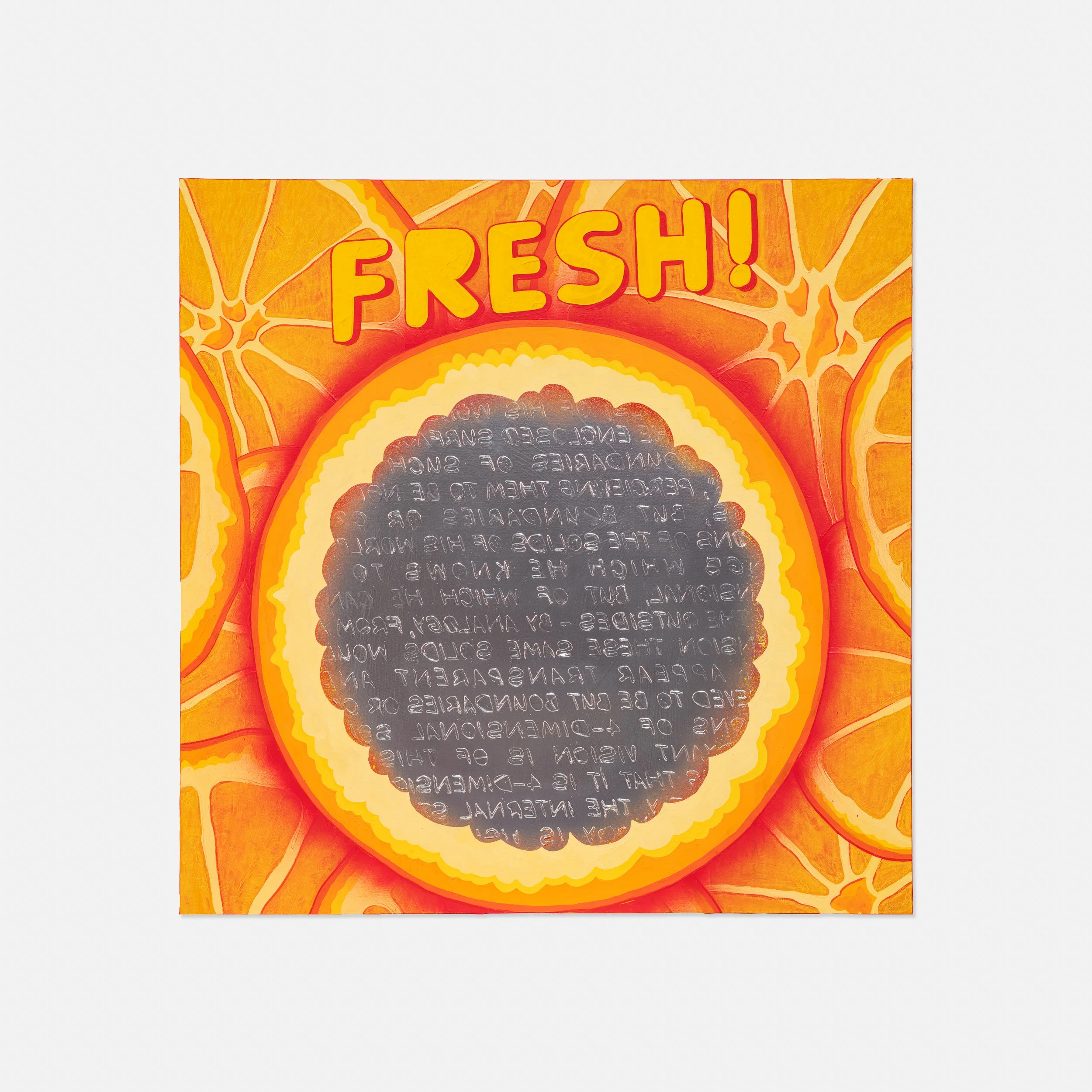All whom you see here is what I am
Anna emina
In the winter of 2022, when all I could do was visit exhibition after exhibition searching for something I could not name I found myself in front of The Secret Way (El Alamein) 2022, a painting by artist Leili Walker. I was enchanted by it all. The way the dark green and blue hues engaged confidently, almost self assuredly against the energetic and vibrant orange. The way the lights in the windows, and on the signage, were all lit, energising the cityscape. How the oranges, like a stream of water, cascaded down the stairs, as though it is where they had always belonged. The fact that there were no doors, only windows, in which you are free to enter, left me limitless as to where I could go. All these feelings, strangely take me back to the surreal and dreamlike landscape of The Mysterious Voyage of Our Homer, an episode of the Simpsons where Homer, having eaten an insanity chilli, goes on a trip to find his soul mate. Unlike Homer, there is no space coyote guiding me through the many possible cosmic and endless universes. All of it, the freedom, the multitudes of meaning, the expansiveness of this one painting left me perplexed when three years later — almost to the day I first encountered The Secret Way — Leili tells me that in the real world, they have been forced to contain their expansiveness, carve off parts of themselves into a perfect saleable commodity, dictated by an online algorithm.
Perplexity should be reserved for those who are unaware, but I had an intimate understanding of what Leili was describing. While I felt pulled between apathy and nihilism, for Leili, what emerged from their reduction of self was anger and cynicism. In the years prior to this encounter, I labelled myself as a “dumb bitch”, a different but nonetheless effective way to become a saleable commodity, to package myself for a society that punishes intellect — especially from a Muslim woman. For two years, I traded medical books and art theory for doomscrolling on TikTok and endless online shopping. It is just as I’ve started to emerge from this “dumb bitch” era that Leili and my paths converged. Leili’s feelings of frustration were the seeds that propelled their new body of work In The Shape Of Another, their second solo exhibition at Backwoods Gallery.
The exhibition consists of eight paintings, an installation of seven mirrors and two sculptures. Each painting is named after the street where the reference photograph was taken, from around Melbourne/Naarm, where Leili is based, and from their travels to Singapore and Iran, the latter, their homeland. Each painting is also a perfect square, 40 x 40 inches, referencing the now retired Instagram square grid.
Leili begins in Singapore’s famous Orchard Rd, a tree-lined, one-way boulevard flanked by shopping malls and hotels. The version Leili depicts resembles little of its referenced location; any sense of self and place is removed. There is no sky line, no indication of the figures' place in the world, and no clear roads, buildings or landmarks in sight. The painting has been stylised as a digital landscape, disconnected from the real world. The figures – one sitting on the curb, the other standing across – are placeless. Their eyes are not visible to us viewers. There is very little to derive from who these people are. Talking to Leili, I come to understand that the standing figure is their mother Firoozeh and the second figure, extending beyond the physical frame at the base of the canvas, is the artist themself.
This sense of placelessness continues in Sydney’s Roslyn Gardens and Melbourne’s Easey St. These paintings have been based on photographs taken by Leili, which were then digitally manipulated to represent how easily content on social media can be distorted.
In both paintings, we only see outlines of the figures. There are no facial features to distinguish them; they blend into their surroundings. The only information we are given are the titles of the paintings. While we focus on the figures, question after question emerges, with no answer offered by Leili. Who are these people? Where is Leili? What am I supposed to be looking at?
The fragmentation and distortion is intentional. During the making of these three paintings, Leili asserts their belief that the self is immaterial and unknowable. Rebelling against the need to label and define themself, or to even identify with anything: “I don’t want anyone to know anything about me.” Leili is using their identity and memories reconstructing them so that the full picture is out of reach, which is also revealed in the painting process. Each painting is textured and layered with thickeners, gouache, pastels, oil and acrylic paints and pencil.
The feelings of anger and frustration, and of wanting to be unknowable, work in tandem, until, Pigdon St, where they slowly start to give way. In examining the self, Leili has chosen to depict the people that most often surround them. Their mum Firoozeh (Orchard Rd and Enghelab St), father Don (Qavam House), older sister Danielle (Roslyn Gardens), friends Eily (Easey St), Pash (Arena), Germ (Gower St), Beatrice, Nina and Sophia (Pigdon St) appear throughout the exhibition. Leili appears on three occasions: in Orchard Rd, Roslyn Gardens and Qavam House and always with someone else. One would think that an exhibition investigating the self would result in the person as the central subject. But Leili has chosen instead to use the loved ones around them to reflect and attempt to understand themself.
They base this idea on The Looking Glass Self, a theory by Charles Horton Cooley, who argued that we shape our sense of self based on how we think others see us (Cooley. 1902). Using social interaction as “a type of “mirror,” people use the judgments they receive from others to measure their own worth, values, and behaviour.” Cooley further suggests that “self-concept is built not in solitude, but rather within social settings. In this way, society and individuals are not separate, but rather two complementary aspects of the same phenomenon” (Lesley University, 2019) Using Cooley’s theory, Leili imagines how they appear to others and their judgment of that appearance by painting the people around them in a type of self-portrait. It seems at this point in the exhibition that Leili is coming back to themselves, taking back control of their online identity and returning to the physical world and the people around them. In a way, Leili reconciles the different versions of themselves that they have created. Their reflection comes full circle, Leili describing how they are “built by and from the people you see embodied” in these paintings. No longer unknowable, they come to state “all whom you see here is what I am”.
It would be easy to conclude at this point. Leili’s journey begins with a fragmented understanding of the self: “none of this is real, it's all an artifice to construct a self, a 'brand'.” But Leili’s feelings slowly transform into earnestness as they engage with the looking glass self, and witnessing the reflections of the people they love. With this, I believe that Leili’s also seeks to exercise the right to opacity.
Opacity is generally used to refer to a lack of transparency or translucence. It is a state in which light cannot pass through. For example a white wall is opaque, as is a mirror (Lee, 2020). Édouard Glissant, the Martinican philosopher and poet uses ‘opacity’ to challenge the Western tendency to demand full knowledge of others, particularly in contexts of power imbalances such as colonialism. In order to be understood in society, an individual is forced to reveal all parts of themselves. In doing so they become transparent, open to being measured, compared and judged against the standards set by society. The end result is a reduction of self, that is a fraction of who an individual is or what they can be (Glissant, 2010).
This is how Leili describes their social media presence, as a reduction, requiring them to both distill and divulge who they are in order to be accepted. The online self erases the nuances and complexities of individual and collective identities. There is a performance to the digital self that must constantly be upheld. Glissant’s theory of opacity is a means of resisting the constant pressure to perform and present oneself in a particular way. It is a right to “difference” without needing to become knowable or transparent.
Leili’s trajectory away from the transparent, performative self on social media towards exploring the unknowable parts of themselves is witnessed in, what I’m calling, the shrinking figure. The first four paintings in the exhibition centre the figures as the central focus. Our eyes are immediately fixated on them. By the time we reach Gower St, the figures begin to shrink, relegated to a small section on the canvas. It is as though the more Leili discovers their physical self, the more they choose to connect with the loved ones around them, and the less the figures appear on the canvas. In the last painting of the series, Enghelab St, the figures are in one corner of the canvas. Only their profiles are on display. The lens has shifted away from Leili’s self reflections, moving slowly off of the canvas as we reach the sculptures Self and Trace 2025, the final works in the exhibition.
It is at this point that Leili transforms into true opacity. The mirrors concealing Leili from being known, the question of self shifts away from Leili to the audience. The viewer is now on display. Opening up the possibility of moving beyond rigid definitions and categories, and embracing the fluidity and complexity of the self. If Leili’s exhibition is an attempt to create a self portrait through how they imagine their loved ones to perceive them, and by how Leili feels about the people they love. If that is true, then arethe mirrored sculptures not also a type of self portrait? If Leili’s parents, or sister, or housemate, visited the show and looked into the mirror, how does it differ from the paintings of them that Leili has created? There are infinite possibilities of self portraits just as there are infinite possibilities of who Leili is or could be.
As I come to the end of the exhibition, I notice the reflection of oranges in the sculpture Trace 2025. Unlike in The Secret Way, the oranges are not flowing down a flight ofstairs but are unveiled in the reflection in the mirror. I am reminded of a quote from Glissant “As for my identity, I'll take care of that myself ” (Glissant, 2010). In observing Leili’s transition to opacity, to not be reduced, they too are taking care of their identity. When I ask Leili how they see themselves as an artist after this exhibition? They respond with “I want to paint some worms. I wanna go back to painting worms. I wanna paint silly things”. It is witnessing Leili's journey of self that I discover that our paths are converging. Leili, slowly coming down from the esoteric, loosening the grip of intellectual thought of needing to constantly define themselves, who they are and where they fit into the world. I in-turn am coming to the same conclusion, that I have the right to not be reduced, I too am free to take care of my identity and become opaque. I don’t require the title ‘dumb bitch’ to define who I am but recognise that there are parts to myself I am yet to discover.
Cooley, C. H. (1902). The looking-glass self. The production of reality: Essays and readings on social interaction, 6(1902), 126-28.
Glissant, É. (2010). Poetics of relation. University of Michigan Press.Lee, C.(2020, December). Opacity. Art Papers. (https://www.artpapers.org/glossary/opacity/)
Lesley University. (2019). Perception is reality: The looking-glass self. Lesley University; (https://lesley.edu/article/perception-is-reality-the-looking-glass-self)






